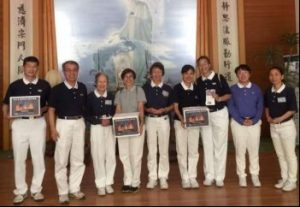
I like to tell people that I grew up in a construction zone. My dad is a do-it-yourselfer, and over the course of my childhood he managed to add an attached garage, a bedroom, and two bathrooms to my childhood home.
He did all of this while working full-time at a factory and raising five kids with my mom. I was always impressed by his ability to turn a pile of dry wall and two-by-fours into something useful. But I was also intimidated.
My lack of hand eye coordination along with my inability to hammer nails in a single blow barred me from learning the secrets of his labor. I just admired his work from afar and did my best to stay out of the way.
When I was older, I took a sabbatical from the marketplace and traveled the country working on organic farms. Coincidentally, one of the farms I lived on needed a building apprentice, so I spent my time there following the building leader around the property helping in any way I could.
We installed cook stoves and repaired furnaces. We also built a tiny house.
It was during the construction of that house that I was bitten by the DIY bug. Turning a pile of wood pallets, cedar slabs, and two-by-fours into a house was a life-changing experience.
I still remember the day I was sitting inside the house with another apprentice. It was the middle of winter and freezing cold outside with the temperature barely breaking four degrees Celsius.
We were going to be working inside for the rest of the day, installing floors and strengthening the earthen walls.
One of us, I forget who, had the idea to light up the stove, so we could enjoy a little heat during our labor. I filled the wood stove with kindling and a few smallish sticks to get it going. Then I lit a match and threw it in.
The flames started off small, but they grew quickly, and I ran outside to admire how all of the smoke was being expelled through the chimney that we’d put in.
When I came back inside a few minutes later the temperature in the house was starting to rise. And it occurred to me that one day our tiny house would be someone’s tiny home.
One day, another human being would come through the front door, just as I’d done, and marvel at how much warmer it was inside than outside.
They’d walk across the floor that I’d installed—a floor made from recycled wood pallets and plywood. They’d stand beside the stove enjoying the heat that radiated from its hot metal surface. And then they might have a cup of tea, or sit down for a meal where they chatted with their family about the market price of corn.
At that moment, I realized that I could follow in my father’s footsteps. I could use my hands to build things; useful things that would help people.
I like to reflect on that moment when I read the Heart Sutra.
The Heart Sutra is a Mahayana Buddhist text that explains Buddhism’s teaching of emptiness and attempts to answer the following questions:
1. Do things exist?
2. If things exist, what is the nature of their existence?
My favorite lines from the sutra go as follows:
“Listen Sariputra,
all phenomena bear the mark of Emptiness;
their true nature is the nature of
no Birth no Death,
no Being no Non-being,
no Defilement no Purity,
no Increasing no Decreasing.”
In this passage, The Heart Sutra responds to the questions I listed earlier by stating that things do not exist, per se. However, a thing exists, and it is in a state of constant change.
As humans, we arbitrarily choose parts of this ongoing transformation. And we give them labels such as birth, death, being, and non-being. But these are illusions. In truth, there is only the transformation.
This is the mark of emptiness.
However, because we are human beings, it is impossible to escape our illusions. We cannot survive unless we label things, and we build entire societies based on the labels we share with other people.
Religions, laws, languages, houses, and so on. All of these things are illusions. But we must treat them as if they’re real.
This is the mark of form.
Our project is to learn how to navigate the relationship between form and emptiness, so that we can save ourselves and others from suffering.
We can see a good example of this relationship by looking at the house that I helped build. In truth, there is no house, per se. There is only the constant change and transformation, which is life.
But in order to live within this transformation, we have to call that object something. We have to understand that the illusion, the house, is dependently originated—created from equally illusory items such as two-by-fours, wood pallets, and earthen clay.
That said, by learning to use those illusory items skillfully I was able to construct a home that provides warmth and shelter to people on cold winter days.
This is the marriage of form and emptiness, and it exists in every aspect of our lives. Like a chef who brings different foods and spices together to create a meal, when we understand the aggregate nature of our illusions, we can construct them in a way that makes life better.
We can rebuild the “houses” of our lives and make them happy places for ourselves and others to live.
Namu Amida Butsu
See more
New Heart Sutra translation by Thich Nhat Hanh (Plum Village)
Related features from BDG
Book Review: Painting Enlightenment: Healing Visions of the Heart Sutra
Mahayana Buddhism and Quantum Physics: Illusion, Emptiness, and Reality
Makers
On Emptiness, Engineering, and Cyberspace
The Heart Sutra: A New Translation












